You’re Drinking It – You Should Enjoy It!
An interview with Sophia and Sarah Boese of Louisville Tea Company
I love tea. I love the taste, the ritual, the somatic experience of drinking tea. My favorite teas – Keemun Mao Feng Imperial, Nandi Hills, Russian Caravan, and especially Christmas Morning (the greatest tea in the history of teas in this universe or any other universe) — come from Louisville Tea Company. Two of the owners, Sophia and Sarah Boese, always greet me warmly and point out new teas I might enjoy. I wanted to learn more about tea, the tea business and what makes tea so special, so I asked them to sit down with me. We enjoyed a lovely conversation over a cup of tea.
Throughout the transcript below, Sophia’s words are in italics; Sarah’s words are in plain text; and my words are in bold.
This was a fun, spunky, engaging discussion. I loved it and I learned a great deal about one of my passions in life – tea. Enjoy!
Photographs by the amazing Megan Resch.
Let's hit the most important question first. Give me your honest view: can you really live a good, ethical, worthwhile, decent, law-abiding life without tea?
I mean, objectively, yes. I do think my life is better with tea in it, for a lot of reasons. I enjoy tea. I enjoy the way it affects me, caffeine-wise, and the rituals of making it.
I don't know, just the cultural experience of having tea. It's a really fun way to interact with other cultures too. I really like learning more about how the Japanese drink tea and how the Chinese drink tea and being able to integrate that into my day-to-day life. And then also bringing some of their practices into my life outside of tea, which is really nice.
There are so many different traditions. And there are even contradicting traditions within different countries. For example, if I recall correctly, with tea sets in China, having an odd number is considered good luck, whereas an even number of cups is bad luck. But you'll see different things in different places.
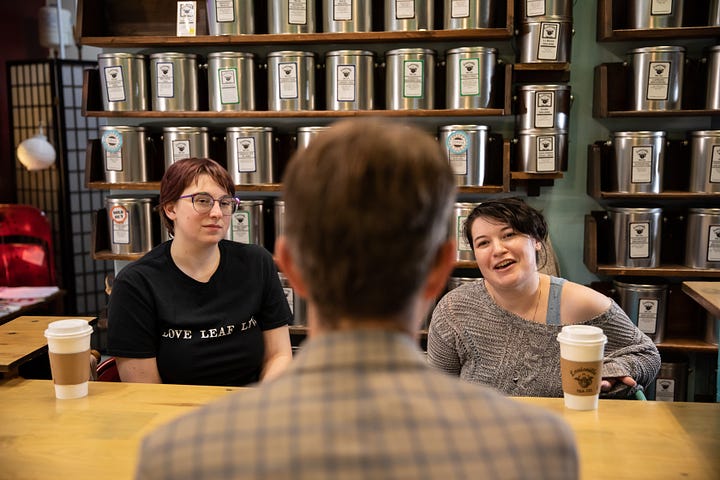
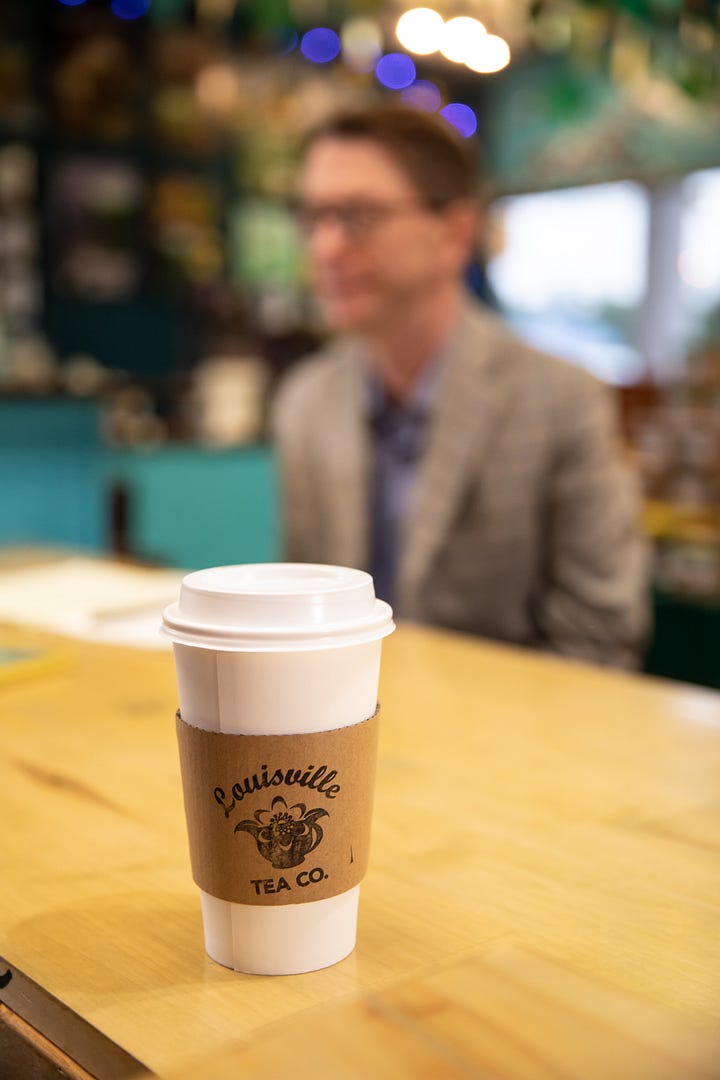
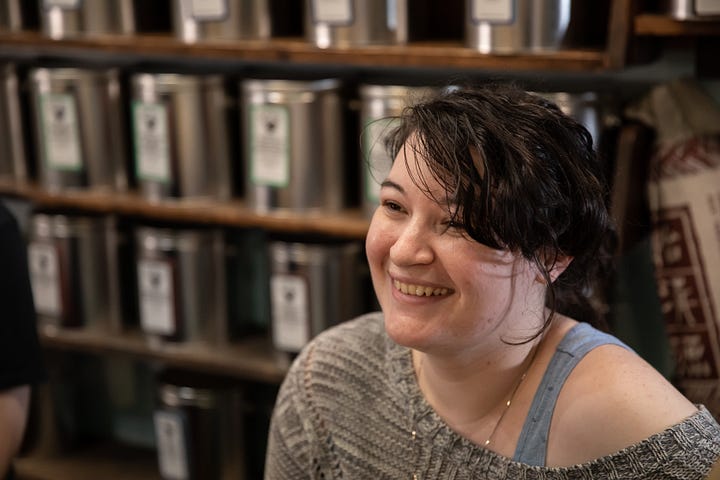
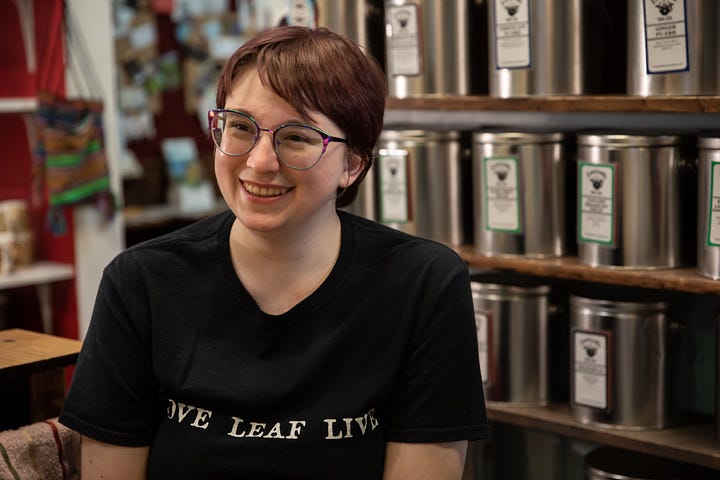
You mentioned incorporating tea and non-tea elements from different cultures into your life. Can you share a couple of them?
My favorite one is actually the Japanese culture of preparing their tea. They sit down and have a full moment with their tea. And I like to integrate that into other parts of my life – I'm going to fully embrace this one thing for this time period and give it the respect that it deserves.
A lot of people who are getting into loose leaf tea for the first time think it's intimidating, so much work and a lot of steps. But that's part of why I like it – having multiple steps to it. You can take your time to breathe and only focus on it and nothing else.
I totally agree. Half the fun is the ritual of it. All the steps.
Waiting for the water.
Waiting for the water.
Actually measuring your tea.
That's exactly right. Are there any other instances you can point to?
I'm not the biggest fan of meditation. I feel like drinking tea and the ritual is my version of meditation.
You can actually clear your mind and just focus on it.
Yeah, have a think moment of it.
I do love the feeling of having a warm cup of tea in your hands. It's very relaxing. Sipping that warm tea, feeling it in your belly before you go to bed. It's very comforting.
And I know this is a big thing in Chinese and Japanese culture – whenever you break a teacup, and then you're involved with repairing it, you’re involved with the glass, with the gold.
It's kintsugi.
An author I enjoy, Tom White, wrote about these sorts of repairs, kintsugi, recently.
Mending ceramics with veins of gold. I've also seen it used in jewelry. The idea is that the repair makes the item even more beautiful than it was before.
The mentality that something broken can become so much more beautiful. It's a really nice mentality to carry throughout life.
But in Korean culture, drinking from a cracked or chipped cup is actually bad luck. It's letting bad spirits into your life and you're not supposed to do that. I've had people ask me before to make sure I don't use anything that might have a crack in it. And I'll say, “Yes, absolutely, we'll respect that. Whatever makes you more comfortable.”
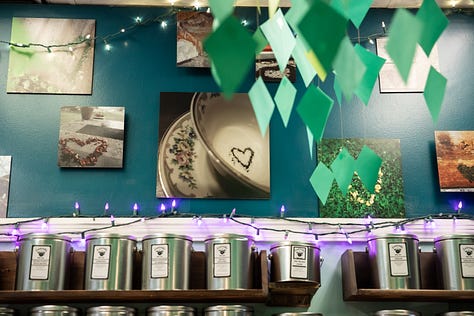
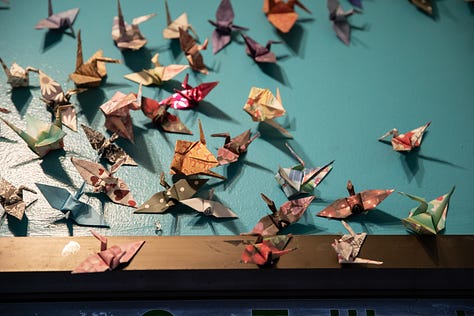
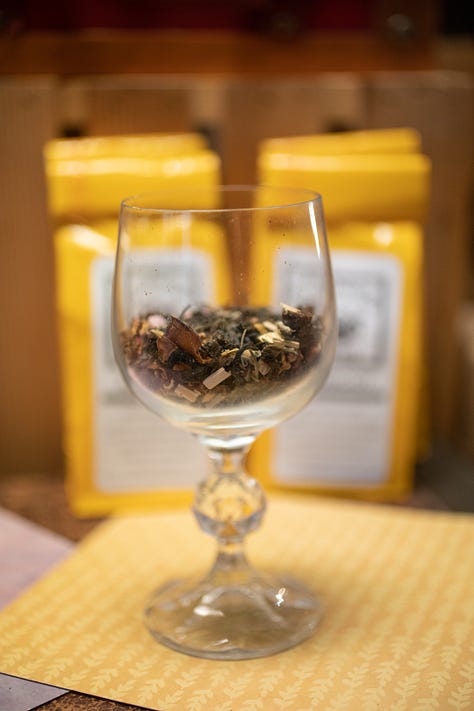
Why do you drink tea?
It’s always been a big part of my life. My whole family drinks tea. So I was born into it. But why I still drink tea – first of all, the caffeine. It is amazing. I do love caffeine. But also it just gives me something to drink. I like having different drinks all around. Water gets boring sometimes. So having fun beverages around is really good.
I would call you a beverage girl.
Yeah, absolutely.
Growing up, my mom always liked unsweet iced tea with lemon, everywhere we went. As a teenager, Sophia was already into tea. Nicolette [Spears, Sophia’s sister and Sarah’s cousin, and another partial owner of the shop] was already very into tea. They're the ones that first got me to taste it and realize that tea doesn't need to have stuff added to it. Tea can be really tasty on its own. As a teenager, I also drank a lot of coffee and energy drinks. My caffeine tolerance was very different than it is now. Now, as a 25 year old, I cannot have caffeine after 6pm. And honestly, my black tea cut off is around 4pm. Also, I like the wide variety of tea. We normally have 160 to 200 different kinds of tea in the shop. So when people tell me they don’t like tea, with so many different types, I know there's going to be something you enjoy.
If you're open to it and willing to give it a try, you'll find something you enjoy, even if it is just a chai latte.
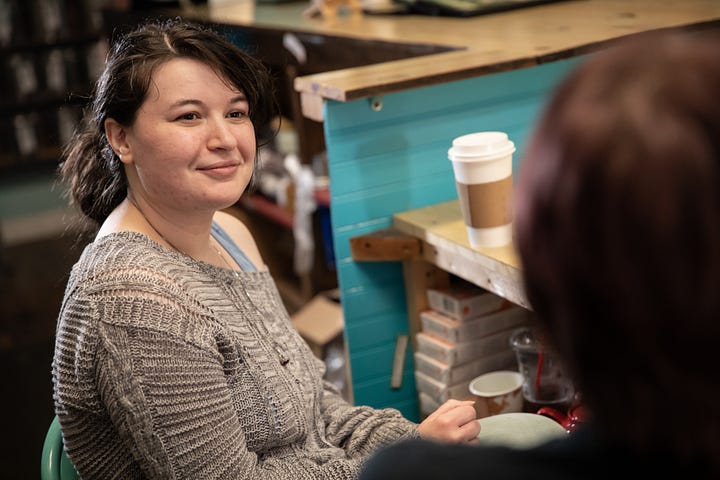

It's one thing to enjoy drinking tea, or even appreciate the ritual in making tea, and an entirely different thing to own and run a tea shop. Tell me how Louisville Tea Company got started and why you are involved.
My sister Nicolette used to work at a tea shop in Arizona. When she moved to Louisville, she realized there was no tea shop in this area. And then I would come visit and we would be in desperate need of tea. And we're thinking, “there's no tea here!”
Sophia would come from Arizona and be tasked to bring tea from the tea shop Nicolette used to work at.
We needed tea here. So then Nicolette and Nick [Spears, Nicolette’s husband and a part owner of the shop] decided to open up a tea business. And I really liked that idea. So after I graduated high school, I decided to come and join them. Then Sarah followed suit soon thereafter.
The business has been open for 11 years now. Soph officially moved here seven years ago. I've been here for six years now. Now, all four of us own the shop.
I don't know why your answers made me think of this, but tell me about the bubble or baba tea phenomenon.
Boba.
Boba, baba, bubble, whatever.
When you're reading this interview, I totally get you.
Do you like it?
I love boba.
Yeah. I think it's really good. We get boba together a lot.
We don’t serve boba because we are not set up to make it here. But I'm a big fan., I was a big fan before I came here. As a little kid, my favorite pudding was tapioca. And it still is, which I realize is the old person pudding, but whatever. I always liked it.
Pudding is the old people's pudding.
Yeah. Boba is like a milk tea. You'll have a dark tea base with milk and sugar, and large tapioca pearls. Normally with brown sugar or something inside them.
My kids tell me, “take us to the boba tea place!”
Have you ever had it?
I have taken sips of theirs.
You’re not a fan of the texture?
I think it is the texture that bothers me.
Yeah. I know a lot of people who don’t like the texture.
It’s funny because my boba drinks tend to not even contain tea. I get lemonades with fun things in them because they're tasty.
Mine tend to be closer to milkshakes.
We definitely love boba and like people who like it.
We get stuff that is so different from what we serve here.
That's a good point. Boba is really different from what you all serve here.
This is a bit of a tangent – but when we first opened, we didn’t have all of this retail. We only had a bunch of tables.
Oh, okay.
So it was more focused on being somewhere to sit and enjoy tea. We had scones and that was about it.
We had a couch here at one point.
This lower bar wasn't here, if I remember correctly. But it didn't bring in a whole lot of revenue. We were still new. We didn't have a known customer base. We shifted to carrying a lot more retail and teaware items. We realized no one was fulfilling that niche here. If people wanted those items, they had to buy them online. Today, half of what we are is essentially a gift shop. I will see a lot of regulars only around the holidays because they're buying gifts for people. They're not even tea people themselves.
What are your all's favorite teas?
I am a big traditional person. I used to be a lot more into flavored teas, but nowadays I feel like I'm mostly doing traditional teas.
When you say “traditional,” what does that mean? Black tea?
Black teas, white teas, any tea that doesn't have anything added into it.
So no fruit or flowers?
Traditional teas tend to be only the tea leaves from the plant.
The way our menu is organized – the first couple pages are traditional teas. These are the straight tea leaf, nothing else. The following pages are the flavored teas, which includes a wide array of teas. They can have spices added or orange peel, for example.
Anything with flavor added into it is on the flavor pages. That's what most people get. Again, there's no wrong way to drink tea.
The very first tea from here that I dranks was Bourbon Cream, which is a very rich, cocoa heavy black tea. But nowadays it's a little sweet for my palate. I drink a lot of Peaches n’ Cream, which is a peach vanilla black tea, when it's hot, it tastes heavier on the vanilla. And when it's iced, it tastes more peachy; it’s a little more refreshing. I also like Black Pearl, which is a traditional dark oolong with undertones of apples and honey. I really like that one because it can be resteeped – you can use the leaves more than once. They're actually a rolled leaf. Each time you brew it, it unrolls a little bit more and you get a slightly different taste.
You mentioned oolong. Can you tell me a bit about the different types of tea? Black and oolong and green and so on?
So first things first, all tea comes from the exact same plant.
Do you want to be fancy? It's the camellia sinensis plant.
All tea comes from the exact same plant. What makes different types of tea is how it's processed after it's picked or when during the season it's picked. White teas are the lightest of the teas. They tend to be the first picked and the least processed of the teas. Black teas tend to be the last picked and go through more oxidation.
White tea is picked and almost immediately dried. Whereas black tea goes through almost 100% oxidation. Oxidation refers to its exposure to the air. It can mean roughing up the leaves a little bit. But with black tea, oxidation makes the tea much darker and much more caffeinated. It can also make it more bitter.
That's also where the color of the tea comes from. I'm drinking a white tea right now. You can see that it's very light in color when compared to this black tea.
One of the easiest ways to explain it is looking on a scale. Black tea is your strongest, darkest and most caffeinated. Below that you have oolong tea. If black tea gets oxidized 100%, then oolong gets oxidized somewhere between 70% and 30%. You can have dark oolongs with more oxidation versus light oolongs with less. Below oolong tea is green tea, which gets oxidized at about 20% Finally, at the bottom of the scale, there is white tea, which doesn't get any oxidation.
Then Pu-erh tea is special. It’s fermented, which is a different process than what happens to other teas. The fermentation makes pu-erh earthy and dark. .
The fermentation also makes it really good for your digestive system. If you want something to help with gut health, we recommend pu-erh. It can be a bit of an acquired taste because it is so earthy and so dark, but it's not too heavy in caffeine.
What about matcha tea?
Matcha is a Japanese green tea that has been ground up into a fine powder. With most teas, you brew the tea then you strain the leaves out. With matcha, the powder is dissolved into the water and you drink it whole.
That's why it's so caffeinated.
You're getting all your green tea benefits, but at a higher level. Matcha gets mentioned in a lot of health articles.
Are there any other big categories of tea we haven't talked about?
Yeah, so there's a lot of different ones. There's like yellow tea, there's purple tea, there's dark tea.
But those ones get really niche. We tend not to have those in our shop. We have a purple tea. Most purple and yellow teas can be categorized as a type of green tea.
Yellow and purple teas tend to be very rare In our shop, we usually only carry yellow teas with our “Extraordinarily Rare Tea Sampler” around the holidays. Occasionally we’ll carry one in limited quantities.
Dark tea is basically a fancy pu-erh. It goes through the fermentation process in a slightly different way than regular pu-erh.
Talk to me about different tea growing regions. It’s grown in India, China and Japan, right?
Again, all tea comes from the same plant. But the ground, the soil, the climate in which it is grown makes a huge difference in how it tastes. Japanese tea doesn't taste anything like Chinese tea.
The same tea grown in different regions is going to taste different. Here are interesting examples of this phenomenon: our Sencha High Grade, which is a Japanese green tea, and our Gyokuro, which is another Japanese green tea. They are exactly the same, except the Gyokuru is grown on the side of a mountain in the shade. So it has to fight a little harder to survive. Those different conditions make for different tastes. Also, the same tea can vary from year to year based on different weather experienced in that region.
One of the funny things we say about tea is the harder the plant has to work, the better the tea normally is.
Suffer for us!
Exactly. If it's struggling to grow in the shade, it develops a much greater depth of flavor.
We had one tea, a purple tea, Purple Wild Buds, named that because it was actually picked wild. It had a really unique nutty flavor. It even had differently shaped leaves, much larger than most tea leaves.
Tea is pretty picky about weather. It likes pretty damp weather, but not too damp. Normally if an area can grow rice, it can grow tea. There are a few places in America that grow tea – around Charleston, South Carolina, for instance.
We visited Charleston Tea Garden last July, which is their picking season. They have the oldest tea plants in the country – a crossbreed of Indian and Chinese plants. It was also abandoned at one point, so some random crossbreeding happened too.
Which actually makes the tea a lot more fun and interesting to taste.
It does.
If the tea's growing into too much of a controlled biome. You're like, this tastes weird.
The amount of harvest you get per year is normally going to be weather dependent. Really dependent on how many inches of rain you get.
So like most crops.
Yeah, exactly.
It is a plant after all.
The standard is what, three harvests per year?
I think so, yeah.
If you've ever heard the term “first flush,” it means the first pick of the season. It tends to have some of the most delicate, highest quality taste.
And is that in spring?
Yes. Spring.
So spring, and there's one in summer, and then there's one in fall?
Basically. It’s in late summer rather than fall.
You all sell a really cool kind gift pack of teas around the holidays, the “Exceptionally Rare Tea Sampler.” How do you put that together and choose those teas?
We mostly find those teas from a tea convention that’s a worldwide tea expo. It’s very big, there’s a lot of people there, it’s very fancy.
And I have not been invited!?
You cannot go because it's only a business thing. I'm so sorry. It is exclusive to people in the business.
I have an LLC and I'm interviewing people about tea right now! That is my tea business. I'm a writer in the business. How am I not in the business?
I don't know what their press stance is.
You should look into it. It's the World Tea Expo and it happens in Las Vegas every year. It is very fun to go.
Yeah, go for it.
And there's a really big showroom in the arena where you can walk around and taste a bunch of teas and interact with a lot of people.
But the expo is focused on getting new teas or new retail products to sellers. There are of course a lot of classes, which focus on topics like tea mixing or tasting notes. I took one class in which a wine sommelier talked about how tea and wine have a lot of the same tasting notes and use a lot of the same tasting language. I do find being here in Louisville, many people know a lot about alcohol and alcohol tasting. So I can say certain words to them and it makes sense to them. With traditional teas, since they are straight teas, you have to describe them based on their undertones. I can say “this tea has a cocoa note to it, there's no chocolate in it, but their undertone is cocoa.” That's how you differentiate it. Someone with experience with alcohol tasting, it’s normally a lot easier to get them on board with that description. One of the reasons we were actually working with a wine person is we were trying to get tea into restaurants. It can be hard to get a restaurant to commit to new teas, especially loose leaf teas, because they’re worried about the process and the time it takes. But if they have a wine sommelier, they normally advocate for good, loose leaf teas. They know the taste and smell and experience benefits of selling fine teas in the restaurant. We currently work with a few different restaurants, coffee shops and breweries in town.
TEN20 Brewery is the new one carrying our teas.
Okay, so I diverted us from the question about the “Exceptionally Rare Tea Sampler.”
Attending the World Tea Expo is normally how we find those teas.
Another way is by getting samples from our suppliers. Specifically for the Exceptionally Rare Tea Sampler, we want to get really rare, really high quality teas that we wouldn’t be able to sell otherwise. And putting six of them in one sampler means we can sell them at a more approachable price range than if we sold one of those teas by itself. Back to yellow teas, I think including them in the Sampler is the only way we’ve sold them.
Because yellow tea tends to be a very high price point, and it's just not an approachable price point for most people. By putting it in the sampler, people who want to taste these super fancy teas have a way to do that.
Going back to the notion of having a wine sommelier – one year I hosted an afternoon tea for some of my Mom’s friends. I came here for the tea. A friend hosted with me. She keeps telling me, “Russell, you need to become a Japanese tea master.” Is there such a thing? Can I become one?
No, you can't become one.
Technically you can be certified to do certain things, especially in Japan.
What does “certain things" mean?
We’ve talked about matcha a bit, right? With matcha in Japan, there are actually very particular ceremonies around it. There are different levels of particularity. You can get a certification to be able to perform them traditionally and officially. They can get very fancy. For instance, if you're going to be part of the ceremony, you're not supposed to eat or drink beforehand. You're not supposed to talk during the entire ceremony.
These ceremonies take at least an hour. Sometimes they can take seven hours, depending on how many people are participating. There’s no certification for “I know tea really well.” It’s not like that. But you can be certified for certain practices of tea. It depends on the culture that you're talking about too.
So I cannot become a tea master because I am not Japanese?
Non-Japanese people can become certified, but you have to live in Japan.
If I remember correctly, I don't think there is an official title of tea master.
So you’re saying I can make it up? “I AM A TEA MASTER!”
You can absolutely lie to people about this.
I don't know how many people will respect that.
I've worked here for like seven, seven plus years, honestly, and I would not consider myself a tea master. I know so much about tea. It's a long road to learn about tea. You’d be studying for years and years.
I have so much to learn. I have confidence in saying that because I'm of the mindset that there is always more to learn. And there is always new information coming out, such as the idea of matcha having all these health benefits. Now you are reading articles about it all the time, but in the West, that is a new thing. And news and insights about tea are constantly coming out.
But also, America is not, shall I say, an especially ritualistic society.
It's fast-paced.
Right – it's not a ceremonial society. The idea of simply sitting down for an hour and only focusing on your tea – that would blow people's minds. Americans wouldn't know what to do.
We noticed that since Covid, there has been a major uptick in people interested in tea sets. Maybe because people were at home more, they got more interested in making it more of a ceremony, more of a process, and taking their time with it.
Covid made people slow down and appreciate the small things in life.
That being said, at the Expo in 2019, we were looking at stats. Tea, in the U.S., is mostly about ready-made drinks. Bottled pre-made tea, even more than tea bags.
Honestly, that was a big trend in China and Japan too – buying your pre-made bottled tea at the convenience or grocery store.
In Japan, villages that for generations grew and picked tea, the younger generations are no longer interested in it. They cared more about boba or fun pre-made drinks.
Like McDonald’s sweet tea or Lipton Brisk iced tea?
Not so much that. Still a little more Japanese. But there is a labor problem too. Villages where tea is grown – those people are starting to age and the younger generations aren’t as interested in that work.
That’s a fascinating point. Craig Mod is a writer I enjoy a great deal. He's an American, but he lives in Japan. He wrote a book called Kissa by Kissa. A kissa is akin to a coffee house. They have limited menus – coffee and usually a few food items. They're all dying out. The owners are all elderly, usually well past retirement age – and none of their kids want to be involved in the kissa. These kissa tend to be on little country roads connecting different towns. Not Tokyo.
Yeah – that's the thing. You see it more with the smaller villages because the younger generation is just not staying there.
Younger generations always want to rebel against older generations. That's just a fact of life.
Speaking of coffee – how do people connect differently with tea than with coffee?
There are people who get really into coffee and I am not one of those people. But as a casual enjoyer of coffee, I feel like it's on the same level of how we partake of and enjoy tea. There are a lot of nuances to enjoying coffee.
There is an American culture connected to coffee, especially in workplaces. “I need my coffee to get going and to be able to function throughout the day.” Break rooms or cafeterias in office buildings are a lot more likely to have coffee in them than tea. If they do have tea stuff, it's usually only tea bags. I have a lot of regulars who come during their lunch breaks a few times a week. They work in offices which only supply coffee in the break room. In America, I think coffee is much more accessible in the workplace than tea.
It's just one of those things that's always there. So it's easy to get into.
Whereas with tea, of course you have Southern sweet tea. Or you have people who see tea as something medicinal – “I only drink tea when I'm sick or when I want to fall asleep.”
Or – “I only drink matcha because it's super-healthy for me.” And that is a good reason to drink matcha. One of our biggest clienteles is people looking to get healthier with tea. You should also be drinking matcha because it tastes good! I feel like having that health-only approach with tea can be negative sometimes.
Or it can be limiting. People come in with a list of herbs and they say, “I want tea with these herbs because I read that they have health benefits.” You absolutely can do that – we have a medicinal section in our menu. But it’s a bit of a different view of tea, and I don't think people approach coffee in quite the same way.
Definitely.

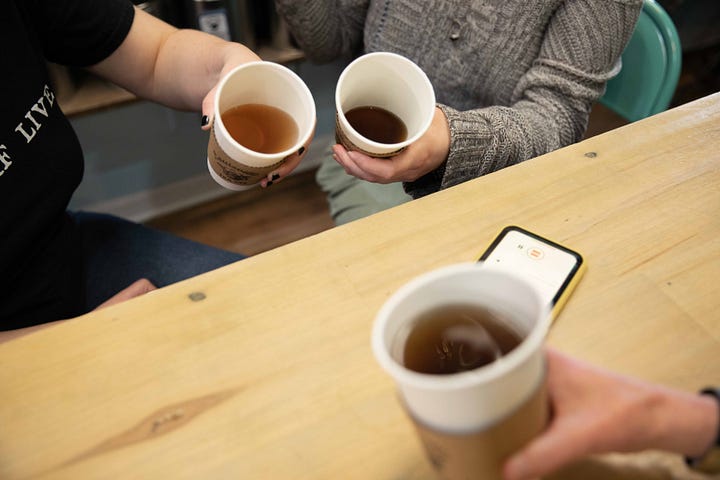
I want to come back to the question of connecting with tea. How do you see people connect with tea?
A lot of people come in who do like the taste. They love exploring the different flavors. We have a lot of different teas for a reason, even if it can be intimidating.
It's such a person-by-person, intimate experience. There are definitely people who only drink it for health benefits. Then there are some people who drink tea every day because it's part of their ritual and it's their favorite thing to drink.
I love the experience of people coming in to buy tea for other people. It’s an easy bonding point –” I know they like tea. It's the easiest thing I can get for them that I know they'll enjoy.” It's a safe move.
Exactly.
My sister-in-law and I – one of our closer bonding points was how much she loves tea and her getting my brother to start drinking tea finally. For a long time he would only drink tea when he wasn't feeling well.She opened him up to enjoying it. And he's a big coffee drinker, – like four shots of espresso per drink. So that was a big thing. Now when I send her tea, he has requests too.
Tea also tends to be a community thing – sharing like a teapot with a friend, for example.
Even in that medicinal vein, I'll have people come in and say, “My daughter-in-law is having her first baby. So I want to get her the New Mother's Tea.”
My wife doesn't love tea, but she loves going to tea. That's one of our favorite things to do as a family over the holidays.
One of my favorite memories with family visiting us here – Sophia’s now sister-in-law and my mom were in town. We went to Sister’s Tea in Buckner, Kentucky. They had the three-tiered tea trays. We all dressed up. It was a whole experience and it was lovely. Unfortunately, that place has closed.
How many people come in here asking for coffee?
A lot. Most are joking. When they’re serious, I will say there is a reason we don't carry coffee. We have some really delicate teas and if they were stored next to coffee, they would start tasting like coffee. So if the options were having a wide range of teas or having teas and coffee, we chose the wide range of teas. There are a lot of amazing local coffee businesses.
Tea and coffee, they are so similar. Many people view them as on the same plane. But they are also so vastly different because they involve vastly different brewing processes.
I'll enjoy a cup of coffee, but I could not tell you how to properly brew anything fancy.
I've never drank coffee in my life.
What are some good books or articles about tea?
I do have one off the top of my head – 19 Lessons on Tea. It’s an easy intro on all the basics, like the different types of tea, what makes them different. Uh, actually, I think Nicolette, my cousin, is quoted or thanked in it.
Away from the shop, could you tell me about some of your tea rituals? What does tea mean to you? How do you celebrate it? How do you drink it?
On my perfect day off, if I have no obligations, I'm sitting at home and I love to make tea in the Gaiwan style. So it has a full little cup and a little lid. You make a bunch of brews of the same tea over and over again. I like to do this with the Tung Ting Oolong that you can steep multiple times. It goes all day. It's ridiculous. Something about the process of making the same cup of tea over and over again and noticing the small details in it and being able to appreciate this full tea for what it is. It's really good.
Tell me more about gaiwan. I have a gaiwan travel set, but I don’t use it much. I have this set.
Honestly not trying to push it, but I love carrying this set around. I mean, it’s just so cute.
This is the one I use at my own house too. I love this set.
I really like the glaze on it. It's a very satisfying feel.
Yeah. It's amazing.
Not to be all product placement. It is wonderful.
I'm not endorsing it. I'm saying it's good. Gaiwan is a really great way to brew tea. It's the traditional Chinese way to make tea. It opens up the tea leaves for a much different experience than you would have with brewing the tea.
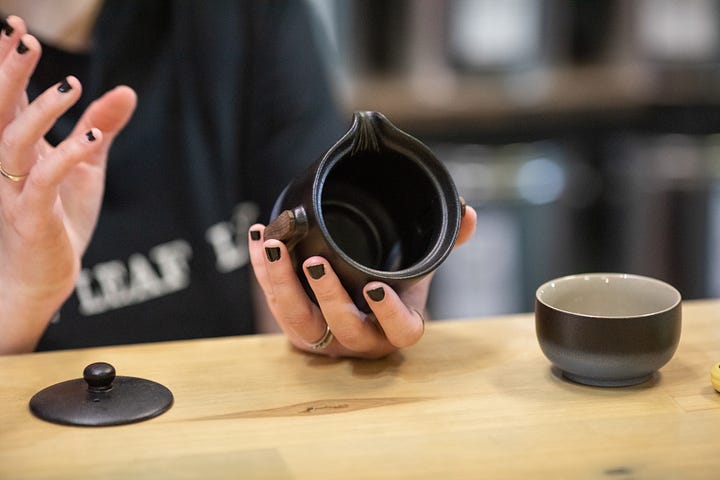

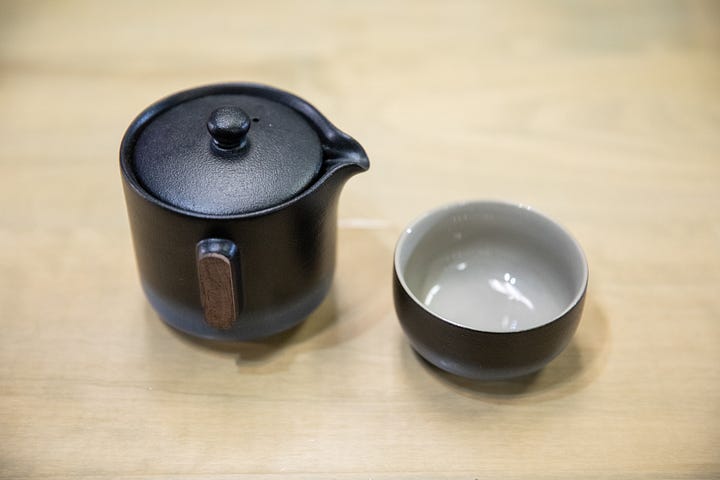
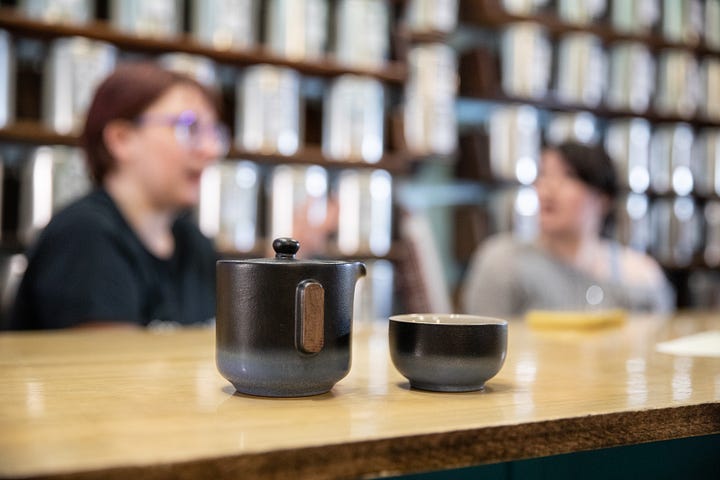
Now you're convincing me to take this on my trip.
With the Gaiwan, you put the tea directly in and then pour the water on top. Then you gently strain the tea. But most of the tea leaves remain, so you're drinking it with tea leaves still in the cup. That’s the best way to drink tea because you get the full body flavor of it and all the nuances of it.
If you ever order a sample cup in the shop, it's made in a Gaiwan. We brew it stronger than we normally recommend brewing tea and you'll get a little bit of the leaf in the cup. So you get the truest flavor.
Just hook them with the caffeine.
Exactly.
You're supposed to use a heaping teaspoon per every eight ounces of water. For our sample cups, we use a heaping teaspoon per every five ounces. So it's not an insane amount!
It's a little bit more than you generally would use.
You can get the real depth of flavor that way.
Do you all drink the Global brands of tea, like Lipton and Bigelow?
I'm going to be real. I only drink our tea. The only time I don't drink our tea is if I’m out at a restaurant and want a cup of tea with my meal. If I'm at a sushi restaurant, I'm going to drink tea. Or, when someone gives me a specialty tea, I will absolutely drink it. Or, when I'm traveling, I like to visit other tea shops and I will drink tea there. But day to day, I only drink our tea.
It is rare that I drink other teas. One of the lovely things about working at a tea shop is people will say, “ I traveled to this country and I brought some tea back. Do you want to try it?” And that is awesome! We also get samples from our suppliers so we can taste a wide range of teas and that is always fun!
But it's not like you sit in the back of your shop and pound a McDonald's sweet tea.
No. We will have the occasional Arizona Ginseng Tea, but that’s almost more of a juice.
Besides here and Trader Nicks Tea in Florida, what are your favorite tea shops?
Sadly, we have not left America. That is something I want to do in my life – travel and taste teas from outside of the country.
Being able to have freshly picked tea from a Japanese tea-growing area would be amazing.
Literal dream stuff like that. Within America, if we happen to be traveling to a city, it’s fun to see what’s out there. We’re originally from Phoenix, and when we’re there, we go to the local tea shops to visit family or friends.
In Phoenix and all of Arizona, I am a Coffee Bean and Tea Leaf fan. They are obviously a coffee shop, but they also have a really nice selection of loose leaf teas. If I have a matcha craving it's my go-to, because they'll give me something good.
One of the funny parts about going to different tea shops is that I am so intimately familiar with the wholesalers that sell loose tea. So I'll be looking at other places’s menus and I'm thinking, “I know exactly where you buy your tea from. And I know exactly what tea I'm getting here because I sell it.” Sometimes I go to tea shops, and it doesn't feel like a new experience because I already know all of their teas because we sell the same teas.
All right. We're done with the nice questions. Tell me about the tea mafia.
The sketchy stuff.
The sketchy side of the tea industry.
The backdoor deals. Yeah. Sadly, it's not that sketchy or anything.
Oh, come on.
I hate to disappoint you. I'm not secretly buying tea from someone at the back door.
The bricks of thousand dollar bills hidden in tea. I know they exist. Come on.
The sketchiest thing we have to do is wire money to people in Japan because we're getting a giant order of fresh tea from Japan.
Generally speaking, we work with about a dozen main suppliers and a few specialty suppliers.
All of our Exceptionally Rare Tea Samplers, we only contact those suppliers for those special teas.
A lot of the exceptionally rare teas are small batch or they come from companies that only do hand picking. So, they have a limited quantity. That's why if a tea is in the Exceptionally Rare Tea Sampler, it's unlikely we will ever be able to get ahold of it again. One time I was at a tea expo and I had a Colombian white tea. It was the sweetest natural tea I've ever had while still being delicate and light. We can no longer find it.
I still think about that tea too, honestly. It's sweet. It was a really good tea.
That's awesome. That's great.
We had a 2007 Hunan dark tea that had natural buttery caramel notes. I would drink that as often as I felt comfortable doing for it being such an exceptionally special tea. We carried it the first two years I was here. We sold out and we can never get it again. And it is probably my favorite tea I've ever had.
Tea is definitely one of those things that gets better with age. Aged tea is a very big thing. If you get something that's aged from a specific year, you're never going to be able to get that tea again. It's aged from that specific year.
These logs over here are from 2012. I'll actually open this up for you.
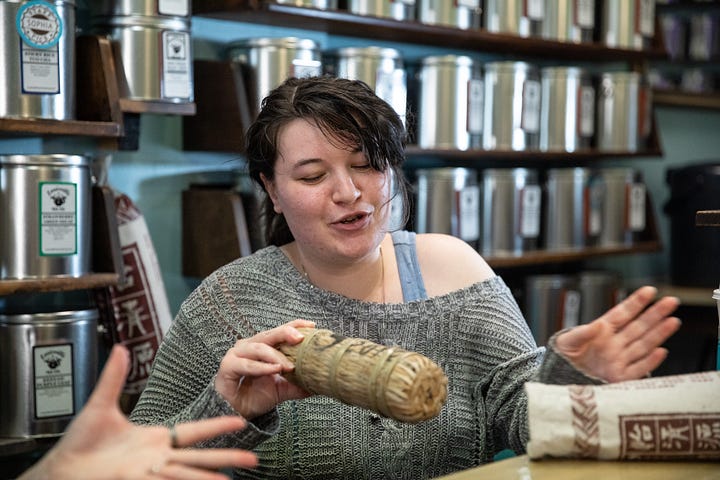
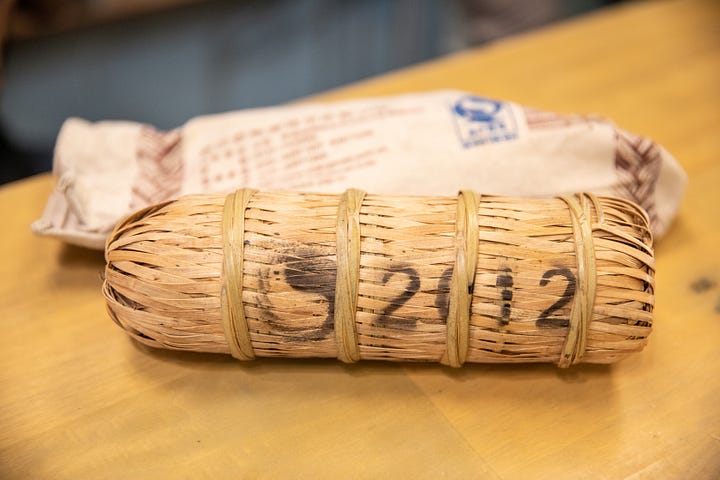
I don't think you ever found a way to sell one of those to me.
Get out, people! Have you never seen this?
No, I’ve never seen it.
This is an aged tea from 2012. It's wrapped in bamboo. It gets more expensive with age because it is actively aging in there.
The price increases every year.
What's the price right now?
It's $65 for the little one. We sold a couple of the little ones. We had a customer who was drinking it on the regular and they said it lasted them about a year.
Right now, this large one is $285. If you're drinking tea daily, it will last you about three years.
If somebody buys that today, will it actually be better at the end, in three years, than it is today?
Sophia: Yeah. If you store it properly. Of course, if something happens to it.
Mostly, you need to make sure it doesn't get exposed to moisture.
We would recommend that you piece off a chunk of it and then seal it back up.
Let me ask a different question. One dirty secret in the restaurant business is – everyone says “sea bass” on the menu, but it’s really some much cheaper fish. You know, like bluegill from Kentucky lakes. What is the sea bass of the tea world?
It would technically be China Keemun, but it doesn't feel like a dirty secret, because we openly tell people about it.
We are pretty honest as a company about our dirty secrets.
We are pretty straightforward with people about this, but China Keemun is a very standard black tea. On it’s own, it doesn’t have much of a unique flavor. It's our cheapest black tea at the moment. It is the base of a lot of flavored black teas.

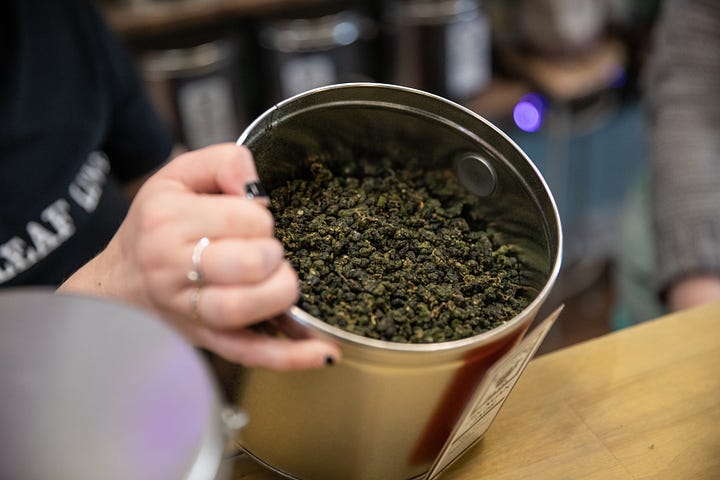
This isn't a tea that you would want to drink by itself much. If you're a big fan of Kentucky Morning? This is what Kentucky Morning is made of. Then the other dirty secret – but again, we are very open about this – is the Milky Oolong controversy. Milky Oolong is a fake tea.
What is it?
Milky Oolong and Milk Oolong are two different things. This is a real Milk Oolong. It’s only oolong tea, nothing added. It gets its taste naturally. It has that creaminess. It tastes like milk. When you steep it several times, it gets milkier. It gets better. Milky Oolong is not that. It has things added to it.
It's artificial. Milky Oolong has been steamed with milk to give you that milky taste. The first couple steeps have the strongest milk taste, but it goes away with multiple steeps, basically the reverse of a Milky Oolong. People will come in asking for Milky Oolong. We can do that. But I tell them we have a true Milk Oolong too, which currently is our Jin Xuan Jade.
And again, we are open about this. I want to tell people that we are not lying to you. We just have a Milky Oolong and a Milk Oolong.
Some last few questions. What’s your favorite thing about being involved in the tea world, having a tea shop and getting to interact with people in a retail environment, but a highly specialized, unique one?
I might be reiterating this, but it’s the communal aspect. We get an immediate connection with people because we already have this shared interest.
Tea can be such a niche interest. When you find someone who also really likes tea, you just want to talk about tea.
It's a strong connection immediately. Comparing it to coffee, coffee is so broad. You're not going to find similarities with people simply because you both like coffee.
Everybody's at Starbucks.
Yeah, like, “oh wow, you drank a cup of coffee this morning.” But if you say, “I drank a cup of tea this morning,” another tea lover reacts, “Ooh, a tea!”
I love when someone comes in, traveling from out of state and they're so excited to see new tea stuff. And they’re excited that someone cares about tea and is excited to talk about it. There's so much to tea. You could be excited about so many different aspects of it.
People come in a lot asking about the right way to brew tea. We have an answer for you. We can tell you how to brew tea.
We have our standard. I tell people the general rule of thumb – a heaping teaspoon per eight ounces of water.
But there's so many different ways to make tea. It depends on the tea. And it also depends on what culture you're interacting with. Someone born in India will brew their Indian chai in a different way from how I will recommend someone from here brew it. The person from India already knows how to do it. They've done it their whole life.
A classic, traditional Indian way of making masala chai is putting the spices and the black tea on the stove with milk and brewing it in milk and then straining it out. But we tell people – letting the black tea sit in hot liquid for that long will actually release a lot of tannins and make the tea really bitter. A lot of our Indian teas are on the much stronger side, because that's more of the palate. In fact, a lot of English tea drinking comes from Indian teas which has a really strong, dark tea base. That's why you'll see people in England putting a lot of milk and sugar in it, to balance out that strength. Then we have some black teas that I would not recommend putting milk and sugar in, because it's going to taste like watery milk and sugar.
You're drinking jasmine green tea? You put milk in it – that's not the right way.
That's a choice. But with Gongfu style, you brew tea for 10 to 30 seconds. And you do that six times or more. That's such a different method from what we normally tell people. That's why I don't like saying there's any hard or fast, right or wrong, ways of brewing tea. People ask what sweetener we would recommend with teas. And I really think that is personal preference. You're the one drinking it, you should enjoy it. You should make it and enjoy it how you like.
Another one people ask about a lot is when to end steep times. Like, don’t ever steep for longer than five minutes or the tea will taste bitter. But some people like bitter tea. If you want to steep it for seven minutes to pull out more astringency, go for it.
I probably steep my tea less than three minutes.
And there's nothing wrong with that either.
Drink it how you enjoy it. I make my tea strong.
I make my tea so strong.
I'll use a 12 ounce cup and put two teaspoons in it.
When we make cups for regular customers, we add two teaspoons in these 16 oz. cups. Every time I make tea for myself, I add three teaspoons because I like my tea strong. I want the added flavor in there.
If I'm making a tea for a health benefit, it wouldn't be wild for me to put six teaspoons in there.
I have absolutely made a cup this size that has eight teaspoons of tea in it. But I've also made a cup this size that has one teaspoon of tea in it.
This is why you can be energetic at the end of the day.
Exactly. This is why we have so much energy.
When I brew our caffeine free teas, most of them don't over-brew. Our labels say to steep five-plus minutes on them. But I'll just tie them off and leave the bag in the cup. I have people who come in and ask me to do that with their regular black teas, which I would never personally do for myself, but it's how they prefer it.
I'm not gonna tell you how to live your life if you're enjoying tea.
You’re the one drinking tea.
OK, so I am curious – what’s your favorite book?
I'm actually a very big reader. I read books every day. And asking for my favorite book is like asking for my favorite tea. I do not have one. I will just ramble about 70 of them!
What's your favorite recent book then?
My favorite recent book is either Song of Achilles or Iron Widow, because I've read them in the past month. That will change next month. I will have a new favorite book, just like I'll have a new favorite tea next month. But I don't know. It also depends on my mood because my favorite fantasy book is nothing like my favorite romance book. My favorite romance book is nothing like my favorite sci-fi book.
Or ones with like childhood nostalgia. So I have a very different answer, because what I consider as my favorite book, I first read in sixth grade. I was about 12 years old. The Giver by Lois Lowry. I read a lot when I was younger, say fourth grade. Then I had a bit of a lull where I didn’t. Then in sixth grade, I picked up The Giver and I was so invested in it, it got me back into the habit of reading. I wrote a book report twice as long as it needed to be because I was so enthusiastic about it. I own a few copies of it because I have some special versions of it. I haven’t read it in years, but it still has a place in my heart.
Multiple versions of books – totally underrated. It’s amazing.
I do it too, honestly. I have fancy editions and then I have copies I actually read because I don't want to read my fancy editions.
That's exactly right.
If I have a signed copy of a book, I have a trash version of it too.
I'm not gonna read that signed version.
I've got about 10 versions of The Iliad and The Odyssey.
I have at least four versions of The Iliad.
I want to see different covers and read different translations.
Sophia's brother, my cousin, Andrew does bookbinding, with his company Optics Binding. So we've received gifts that are very fancy versions of books.
That's awesome.
We both love to read. I think together we have over 600 books at our house. I like to read basically everything. I'll read comics, I'll read whatever I can get my hands on.
If we are talking about books, I have to give a shout out to Percy Jackson, the children’s series.
I read it when I was 12 and I still love it. I have feelings about Percy Jackson the way that a lot of people have feelings about Harry Potter. It was such a big part of my childhood, part of why I love reading.
It got me super into mythology – not only Greek mythology. Sixth grade was when we started studying world history and looking into different mythologies. I still love to look into them.
I own mythology textbooks because they're really fun to read. Percy Jackson got me into that.
I'm not huge into non-fiction books. But mythology got me a lot more into world history and culture.
Well, Sarah and Sophia – this has been so much fun! It’s been awesome!
Thank you! This was great – I'm so happy we did this! This was very enjoyable!
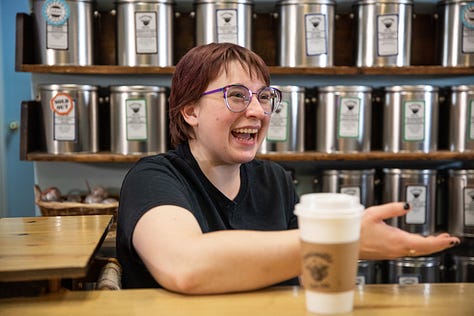
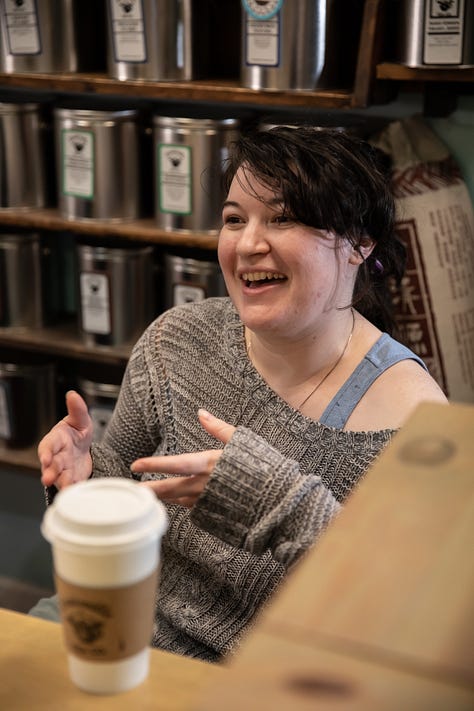




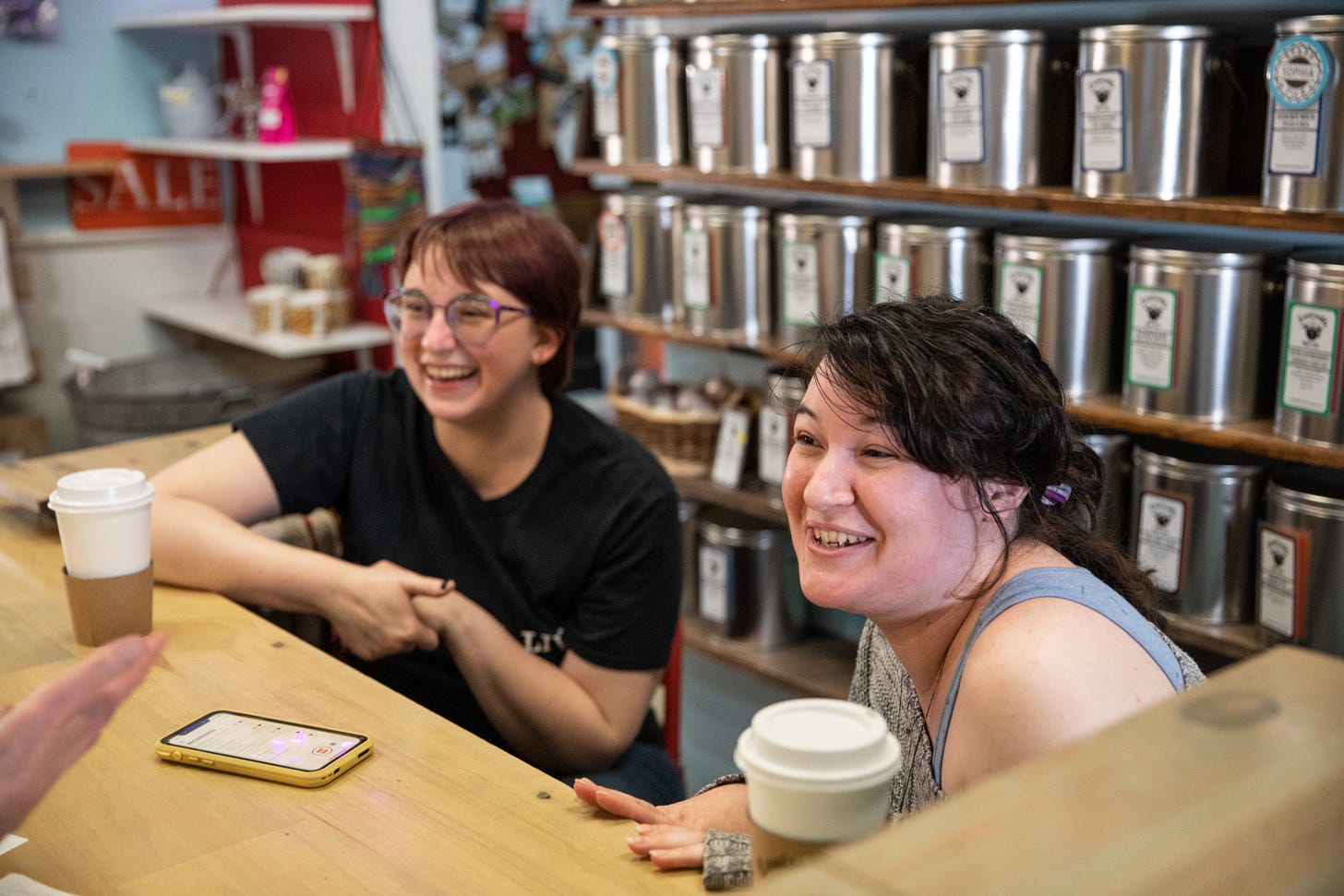
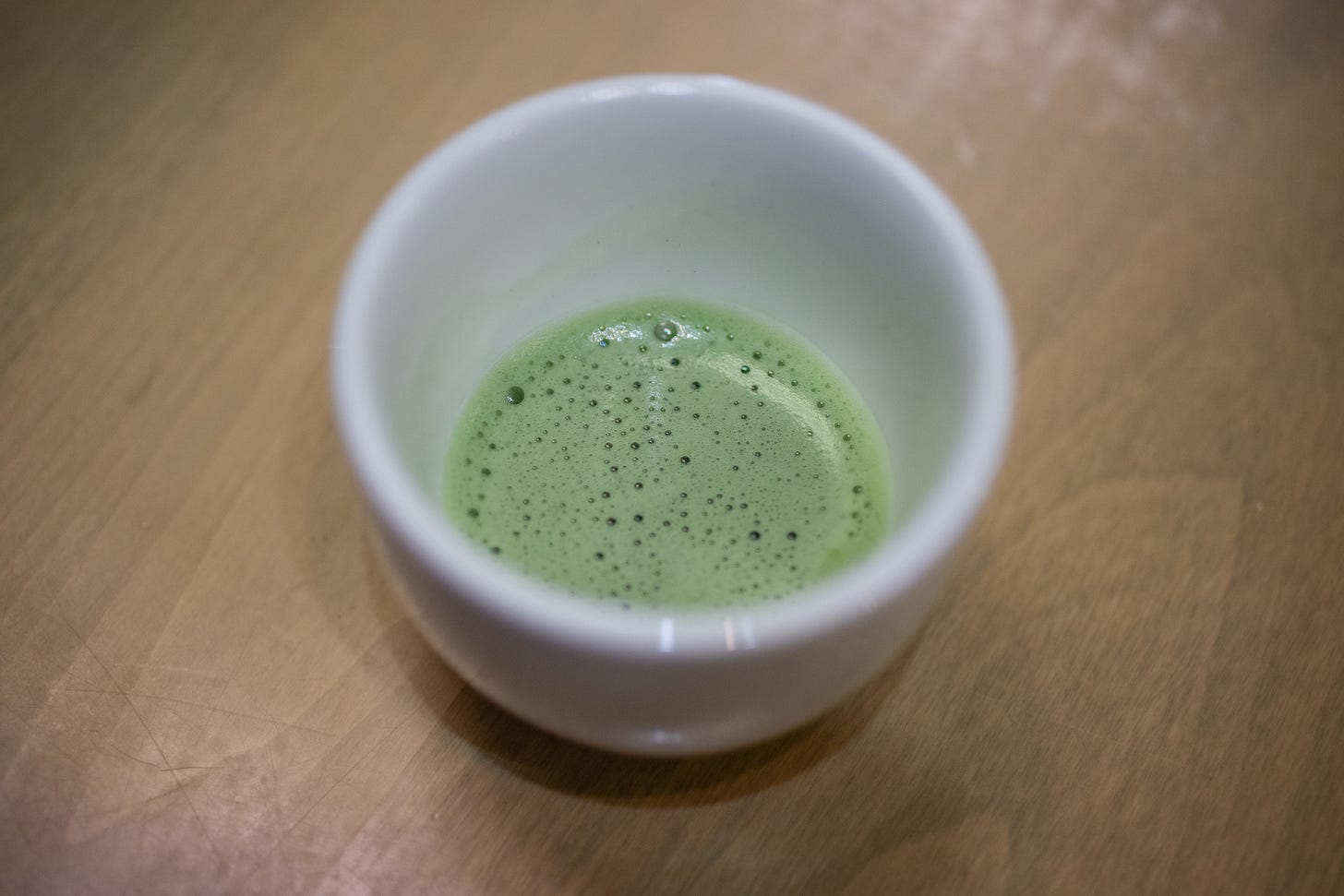
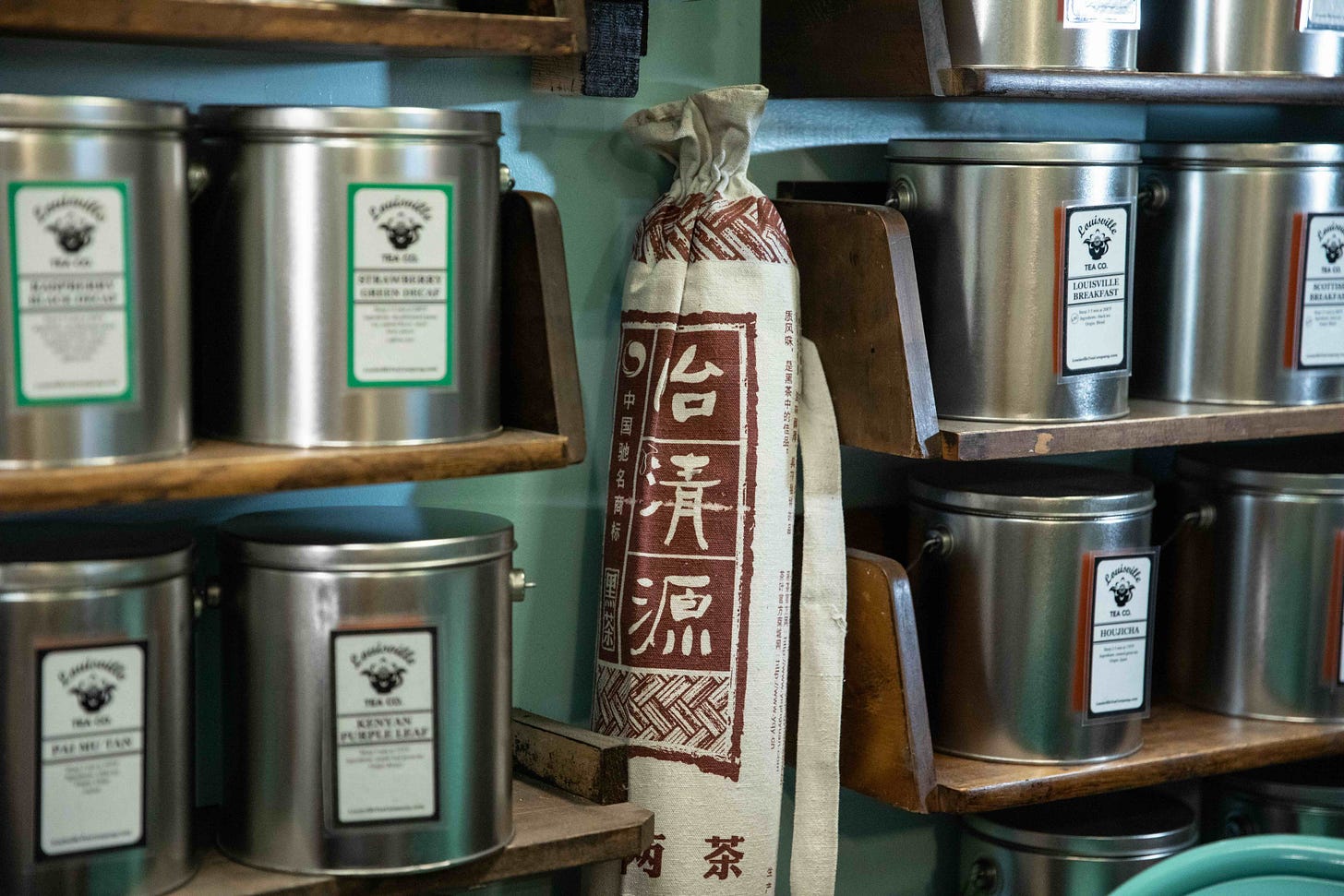
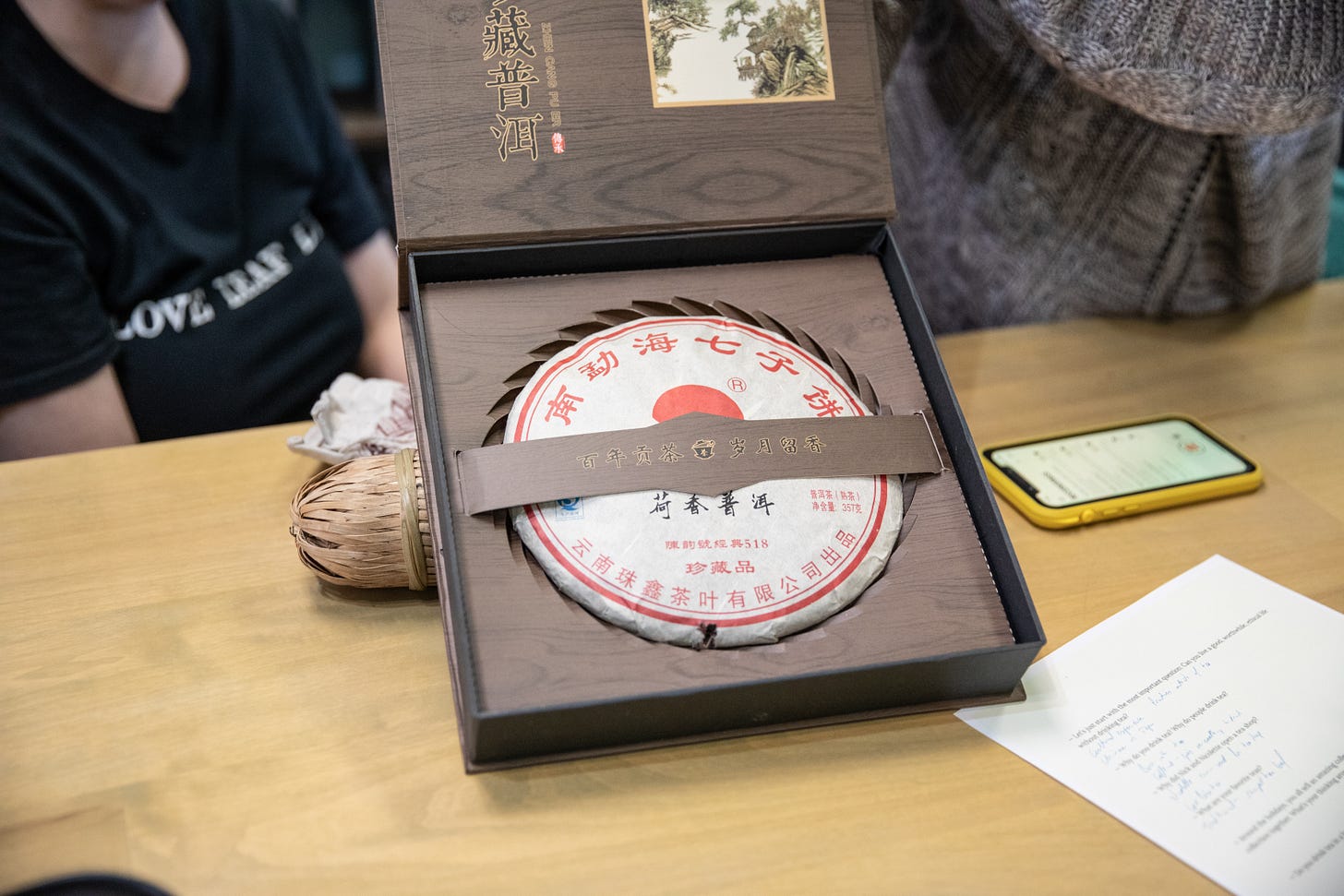
Amazing! Such an in-depth dive into everything tea. And I love the photos. My favorite takeaway is "the mentality that something broken can become so much more beautiful. It's a really nice mentality to carry throughout life."
Oh Russell, this was so wonderful to read. Bravo. I might just have to head on over to my favourite tea supplier and place an order. Ceylon is my jam.